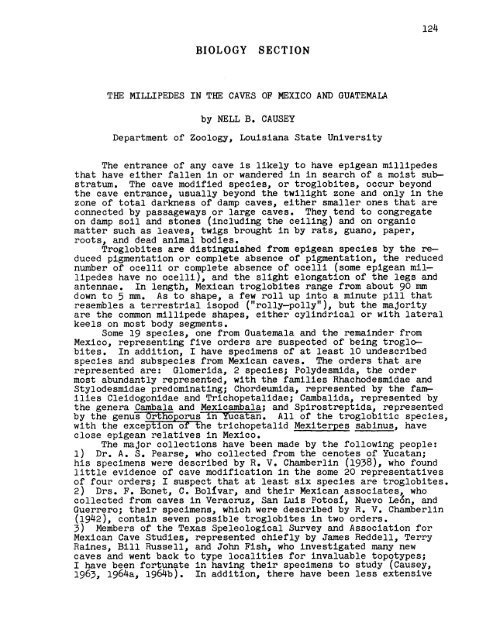17MB PDF - Association for Mexican Cave Studies
17MB PDF - Association for Mexican Cave Studies
17MB PDF - Association for Mexican Cave Studies
You also want an ePaper? Increase the reach of your titles
YUMPU automatically turns print PDFs into web optimized ePapers that Google loves.
124BIOLOGYSECTIONTHE MILLIPEDES IN THE CAVESOF MEXICO AND GUATEMALAby NELL B. CAUSEYDepartment of Zoology, Louisiana State UniversityThe entrance of any cave is likely to have epigean millipedesthat have either fallen in or wandered in in search of a moist substratum.The cave modified species, or troglobites, occur beyondthe cave entrance, usually beyond the tWilight zone and only in thezone of total darkness of damp caves, either smaller ones that areconnected by passageways or large caves. They tend to congregateon damp soil and stones (including the ceiling) and on organicmatter such as leaves, twigs brought in by rats, guano, paper,roots, and dead animal bodies.Troglobites are distinguished from epigean species by the reducedpigmentation or complete absence of pigmentation, the reducednumber of ocelli or complete absence of ocelli (some epigean millipedeshave no ocelli), and the slight elongation of the legs andantennae. In length, <strong>Mexican</strong> troglobites range from about 90 mmdown to 5 mm. As to shape, a few roll up into a minute pill thatresembles a terrestrial isopod ("rolly-polly"), but the majorityare the common millipede shapes, either cylindrical or with lateralkeels on most body segments.Some 19 species, one from Guatemala and the remainder fromMexico, representing five orders are suspected of being troglobites.In addition, I have specimens of at least 10 undescribedspecies and subspecies from <strong>Mexican</strong> caves. The orders that arerepresented are: Glomerida, 2 species; Polydesmida, the ordermost abundantly represented, with the families Rhachodesmidae andStylodesmidae predominating; Chordeumida, represented by the familiesCleidogonidae and Trichopetalidae; Cambalida, represented bythe genera Cambala and Mexicambala; and Spirostreptida, representedby the genus Orthoporus in Yucatan. All of the troglobitic species,with the exception of the trichopetalid Mexiterpes sabinus, haveclose epigean relatives in Mexico.The major collections have been made by the following people:1) Dr. A. S. Pearse, who collected from the cenotes of Yucatan;his specimens were described by R. V. Chamberlin (1938), who foundlittle evidence of cave modification in the some 20 representativesof four orders; I suspect that at least six species are troglobites.2) Drs. F. Bonet, Co Bol!var, and their <strong>Mexican</strong> associates, whocollected from caves in Veracruz, San Luis Potos!, Nuevo Le6n, andGuerrero; their specimens, which were described by R. V. Chamberlin(1942), contain seven possible troglobites in two orders.3) Members of the Texas Speleological Survey and <strong>Association</strong> <strong>for</strong><strong>Mexican</strong> <strong>Cave</strong> <strong>Studies</strong>, represented chiefly by James Reddell, TerryRaines, Bill Russell, and John Fish, who investigated many newcaves and went back to type localities <strong>for</strong> invaluable topotypes;I have been <strong>for</strong>tunate in having their specimens to study (Causey,1963, 1964a, 1964b). In addition, there have been less extensive
















